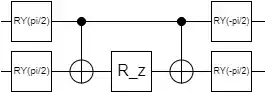I have read the following paper by Dumitrescu et al.
To make a Unitary Coupled Cluster (UCC) ansatz, one prepares with the following equation. $$ | \psi_{\rm{UCC}} \rangle = U(\theta)|\mathrm{HF}\rangle $$ Here, $U(\theta) = \exp[ T(\theta) - T^{\dagger}(\theta) ]$ and $|\mathrm{HF}\rangle$ is the Hartree-Fock state.
Let me consider a simple system where $T(\theta) = \theta a_0^{\dagger}a_1$. Then one obtains $$\begin{align} U(\theta) &= \exp[ \theta(a_0^{\dagger}a_1 - a_1^{\dagger}a_0) ] \;. \\ &= \exp[ i(\theta/2) (X_0Y_1 - X_1Y_0) ] \end{align} $$
Here, one applies Jordan-Wigner transformation.
So far, I can understand but hereafter how can I make a circuit? Should I expand and calculate $U(\theta)|\mathrm{HF}\rangle$ with Baker-Campbell-Hausdorff formula or something?

